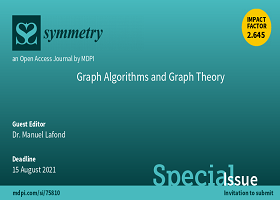Graph Algorithms and Graph Theory
A special issue of Symmetry (ISSN 2073-8994). This special issue belongs to the section "Mathematics".
Deadline for manuscript submissions: closed (31 March 2022) | Viewed by 20295

Special Issue Editor
Interests: algorithms; computational biology; graph theory; parameterized complexity; approximation algorithms
Special Issues, Collections and Topics in MDPI journals
Special Issue Information
Dear Colleagues,
Graphs have applications in numerous areas of computer science, including machine learning, computational biology, social network analysis, and many other areas that require fast algorithms for various optimization problems. Recent advances in graph theory have shown that most graphs exhibit structural properties or symmetry that can be leveraged for the development of efficient algorithms. Important results such as Robertson and Seymour’s minor theory have paved the way for countless results in parameterized complexity, and Szemerédi’s regularity lemma has led to several new ideas in approximation algorithms. Moreover, these results represent only a fraction of the algorithmic applications of structural graph theory that have emerged in the last few decades. This demonstrates that expanding our fundamental knowledge of graphs, whether it be graphs in general or specific classes, is necessary to improve the state-of-the-art in algorithms and complexity.
This Special Issue aims to improve our understanding of the interplay between algorithms, structure, and symmetry in graphs. The goal is to explore new directions in designing graph algorithms and to establish new foundations in structural graph theory.
The scope of the Special Issue includes, but is not limited to:
- the design and analysis of graph algorithms, parallel, randomized, parameterized, distributed, and other types of algorithms;
- structural graph theory with immediate or potential applications in algorithms and complexity analysis.
Dr. Manuel Lafond
Guest Editor
Manuscript Submission Information
Manuscripts should be submitted online at www.mdpi.com by registering and logging in to this website. Once you are registered, click here to go to the submission form. Manuscripts can be submitted until the deadline. All submissions that pass pre-check are peer-reviewed. Accepted papers will be published continuously in the journal (as soon as accepted) and will be listed together on the special issue website. Research articles, review articles as well as short communications are invited. For planned papers, a title and short abstract (about 100 words) can be sent to the Editorial Office for announcement on this website.
Submitted manuscripts should not have been published previously, nor be under consideration for publication elsewhere (except conference proceedings papers). All manuscripts are thoroughly refereed through a single-blind peer-review process. A guide for authors and other relevant information for submission of manuscripts is available on the Instructions for Authors page. Symmetry is an international peer-reviewed open access monthly journal published by MDPI.
Please visit the Instructions for Authors page before submitting a manuscript. The Article Processing Charge (APC) for publication in this open access journal is 2400 CHF (Swiss Francs). Submitted papers should be well formatted and use good English. Authors may use MDPI's English editing service prior to publication or during author revisions.
Keywords
- algorithms
- graph theory
- graph classes
- parameterized complexity
- approximation algorithms
- computational geometry
- random graphs





